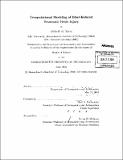Computational modeling of blast-induced traumatic brain injury
Author(s)
Nyein, Michelle K. (Michelle Kyaw)
DownloadFull printable version (10.94Mb)
Other Contributors
Massachusetts Institute of Technology. Dept. of Aeronautics and Astronautics.
Advisor
Raúl A. Radovitzky.
Terms of use
Metadata
Show full item recordAbstract
Blast-induced TBI has gained prominence in recent years due to the conflicts in Iraq and Afghanistan, yet little is known about the mechanical effects of blasts on the human head; no injury thresholds have been established for blast effects on the head, and even direct transmission of the shock wave to the intracranial cavity is disputed. Still less is known about how personal protective equipment such as the Advanced Combat Helmet (ACH) affect the brain's response to blasts. The goal of this thesis is to investigate the mechanical response of the human brain to blasts and to study the effect of the ACH on the blast response of the head. To that end, a biofidelic computational model of the human head consisting of 11 distinct structures was developed from high-resolution medical imaging data. The model, known as the DVBIC/MIT Full Head Model (FHM), was subjected to blasts with incident overpressures of 6 atm and 30 atm and to a 5 m/s lateral impact. Results from the simulations demonstrate that blasts can penetrate the intracranial cavity and generate intracranial pressures that exceed the pressures produced during impact; the results suggest that blasts can plausibly directly cause traumatic brain injury. Subsequent investigation of the effect of the ACH on the blast response of the head found that the ACH provided minimal mitigation of blast effects. Results from the simulations conducted with the FHM extended to include the ACH suggest that the ACH can slightly reduce peak pressure magnitudes and delay peak pressure arrival times, but the benefits are minimal because the ACH does not protect the main pathways of load transmission from the blast to brain tissue. A more effective blast mitigation strategy might involve altering the helmet design to more completely surround the head in order to protect it from direct exposure to blast waves.
Description
Thesis (S.M.)--Massachusetts Institute of Technology, Dept. of Aeronautics and Astronautics, 2010. Cataloged from PDF version of thesis. Includes bibliographical references (p. 105-113).
Date issued
2010Department
Massachusetts Institute of Technology. Department of Aeronautics and AstronauticsPublisher
Massachusetts Institute of Technology
Keywords
Aeronautics and Astronautics.